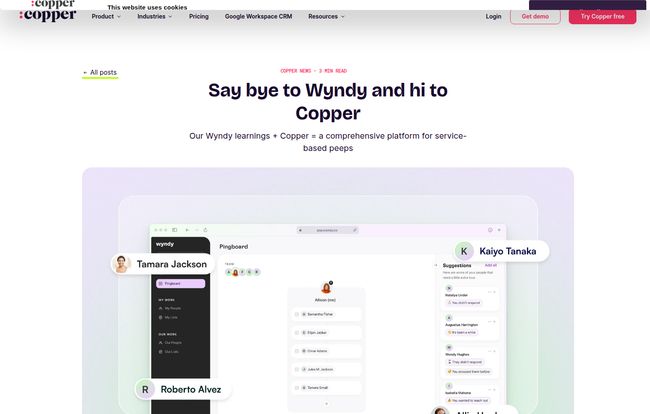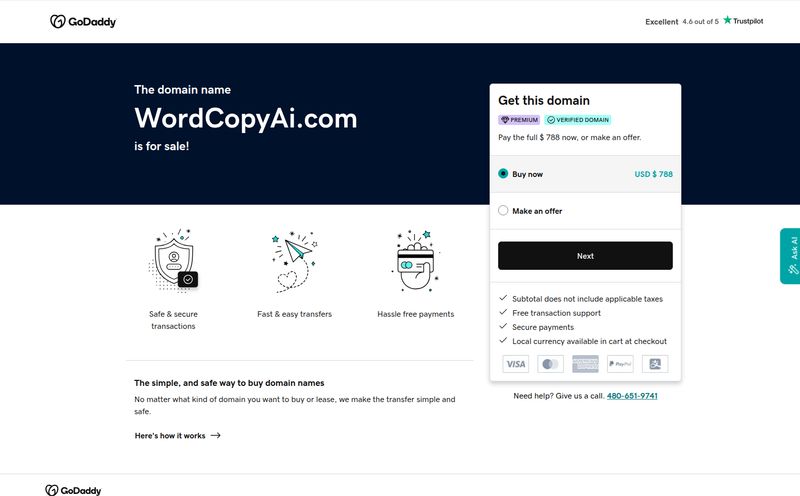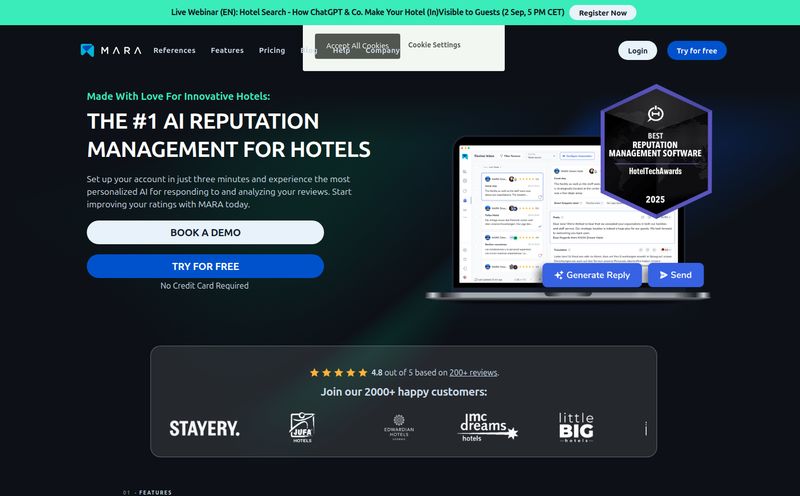Ever stumble upon a new app or a piece of software and just think, "Yes. Finally. Someone gets it"? That was me when I first heard about Wyndy. In a world jam-packed with bloated, over-engineered CRM platforms that require a PhD and a team of consultants to set up, Wyndy felt like a breath of fresh air. It was simple, it was smart, and it targeted a pain point most of us in the sales and marketing world know all too well: actually remembering to talk to people.
It was designed to be the anti-CRM. A lightweight tool for managing the most important part of business—the relationships. But if you go looking for it now... well, you'll find nothing but a ghost. A 404 page and a few old articles. So, what happened to this promising little tool? It's a classic tale in the tech world, one of a great idea, a bigger parent company, and a strategic pivot. Let's pour one out and talk about the short, bright life of Wyndy.
What Was Wyndy, Anyway? The Promise of a "CRM-Lite"
To really get Wyndy, you have to understand what it wasn't. It wasn't Salesforce. It wasn't HubSpot. It wasn't trying to be an all-in-one command center for a massive sales organization. Its focus was beautifully narrow. Wyndy was for the individual—the freelancer, the consultant, the startup founder—who knew their network was their net worth but was just too damn busy to manage it properly.
Its magic was in its simplicity. It was less of a corporate database and more like a personal assistant for your network, one who lived right in your inbox. I’ve always felt the best tools are the ones that remove friction, not add it. And Wyndy was all about that.
The Features That Made It Special
Wyndy's approach was built on a couple of genuinely clever features. First up was the Daily Pingboard. This was its killer app, in my opinion. Every day, it would serve up a handful of contacts it thought you should reach out to. No complex algorithms to decipher, just a simple, “Hey, you haven’t talked to Sarah in a while, maybe send a note?” It was the proactive nudge we all need but never get. It took the mental load off of remembering who to follow up with.
Then there was the AI-powered email drafting. This was pretty slick. It would help you write those little check-in emails, saving you precious minutes that add up over the course of a week. It wasn't about automating the relationship, but about greasing the wheels to make maintaining it easier. A huge difference. It was about keeping connections warm, turning cold contacts into acquaintances and acquaintances into allies.

Visit Wyndy
The Genius of Proactive Relationship Management
Let's be honest, we've all been there. You leave a conference or a meeting with a pocketful of business cards and the best of intentions. A week later, those cards are sitting in a pile on your desk, collecting dust and guilt. The moment has passed. Wyndy was built to solve that exact problem.
It understood that modern networking isn’t just about closing the next deal. It's about playing the long game. It's about staying top-of-mind so that when an opportunity does arise, you’re the first person they think of. It was designed to nurture, not just to convert. For a lot of us who feel a bit grimy about traditional, hard-sell networking, this approach felt... better. More human.
So, Where Did It Go? The Copper Connection
Here’s the plot twist. Wyndy wasn’t some scrappy startup in a garage. It was actually a standalone product launched by the well-known CRM company, Copper. Yep, the CRM that’s famous for its deep integration with Google Workspace.
And that’s the key to its disappearance. In a December 2023 blog post, Copper announced they were “closing the Wyndy chapter.” But this wasn't a story of failure. It was a graduation. Copper realized that the ideas powering Wyndy—simplicity, proactive suggestions, living in the inbox—were too good to keep in a separate, niche product. They decided to fold Wyndy's DNA directly into the main Copper platform.
As Copper put it, they were turning the page “to build a new future for relationship-based growth that lives where work happens: in your inbox.”
So Wyndy didn’t die. It was absorbed. Its spirit now lives on, making a more established and powerful platform even better. A bit of a bittersweet ending for those of us who loved the standalone concept, but a smart strategic move by Copper.
What We Can Learn from the Wyndy Story
The rise and fall—or rather, transformation—of Wyndy holds a few important lessons for anyone in the tech and marketing space.
The Craving for Simplicity Is Real
People are getting tired of feature creep. We don’t always need more buttons, more dashboards and more options. Sometimes, we just need a tool that does one thing exceptionally well. Wyndy's initial appeal is proof that there's a huge market for focused, minimalist software that solves a specific, nagging problem without a steep learning curve.
The Inevitable Consolidation of SaaS
The SaaS world is a bit like the wild west. A lot of cool, independent tools pop up, but many eventually get bought out or absorbed by the bigger players. A great feature is often not enough to build a lasting, standalone company. It often becomes a feature within a larger platform. Wyndy's story is a perfect example of this natural lifecycle.
Was Wyndy Perfect? A Frank Look at the Downsides
Of course, no tool is without its flaws, especially a beta product. While the concept was fantastic, there were some practical hurdles. For one, it required full access to your Google account, which is a standard practice for inbox tools but always a point of hesitation for the privacy-conscious. As a beta, it was also prone to the occasional bug, which is to be expected.
But frankly, its biggest Achilles' heel was the uncertain future. It was offered as a free beta, but there was no clear information on what its final pricing structure would be. It's tough to commit to integrating a tool into your daily workflow when you have no idea if it's going to cost $5 or $50 a month down the line. That lack of clarity probably kept some potential power users on teh sidelines.
The Legacy of Wyndy: Living on in Copper
So, if you were intrigued by the idea of Wyndy, the good news is that its soul lives on. Copper is, for all intents and purposes, its spiritual successor. By integrating Wyndy's relationship-first philosophy, Copper is strengthening its position as a CRM that helps you manage real human connections, not just data points in a pipeline. The focus is still on easy integration with your inbox and taking the administrative work out of networking.
Frequently Asked Questions About Wyndy
What was Wyndy?
Wyndy was a lightweight relationship management tool created by Copper. It was designed to help users maintain their professional network through AI-powered suggestions for follow-ups and email drafting, all without the complexity of a full-scale CRM.
Is Wyndy still available?
No, Wyndy is no longer available as a standalone product. The Wyndy app was officially retired at the end of December 2023.
Why was Wyndy discontinued?
Wyndy wasn't so much discontinued as it was strategically integrated. Its parent company, Copper, decided to incorporate Wyndy's core features and relationship-first philosophy into its main Copper CRM platform to enhance it.
What is the best alternative to Wyndy?
The best alternative to Wyndy is its parent product, Copper. Since Wyndy's features and core ideas were absorbed into Copper, it is the direct spiritual successor and offers a similar focus on relationship management within your Google Workspace.
How much did Wyndy cost?
Wyndy never had a final public price. It was operated as a free beta product throughout its existence, and its pricing structure was never finalized before it was retired.
A Great Idea That Lit the Way
So here's to Wyndy. It may have been short-lived, but it was a fantastic idea that captured a very real need in the market. Its story isn't a tragedy; it's a testament to the power of a good idea. Even in its absence, Wyndy's brief flight teaches us a lot about the demand for simplicity and the future of human-centric business tools. Sometimes the brightest flames burn the quickest, but they often show everyone else the way forward.
Reference and Sources
- Say bye to Wyndy and hi to Copper - Copper Blog



